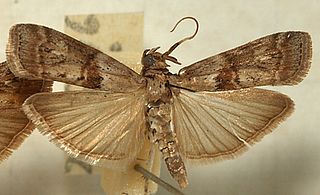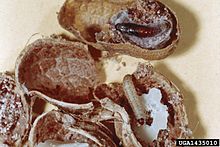
The Pyralidae, commonly called pyralid moths, snout moths or grass moths, are a family of Lepidoptera in the ditrysian superfamily Pyraloidea. In many classifications, the grass moths (Crambidae) are included in the Pyralidae as a subfamily, making the combined group one of the largest families in the Lepidoptera. The latest review by Eugene G. Munroe and Maria Alma Solis retain the Crambidae as a full family of Pyraloidea.

The Indianmeal moth, also spelled Indian meal moth and Indian-meal moth, is a pyraloid moth of the family Pyralidae. Alternative common names are weevil moth, pantry moth, flour moth or grain moth. The almond moth and the raisin moth are commonly confused with the Indian-meal moth due to similar food sources and appearance. The species was named for feeding on Indian meal or cornmeal, and does not occur natively in India. It is also not to be confused with the Mediterranean flour moth, another common pest of stored grains.

The almond moth or tropical warehouse moth is a small, stored-product pest. Almond moths infest flour, bran, oats, and other grains, as well as dried fruits. It belongs to the family of snout moths (Pyralidae), and more specifically to the tribe Phycitini of the huge snout moth subfamily Phycitinae. This species may be confused with the related Indian mealmoth or the Mediterranean flour moth, which are also common pantry pests in the same subfamily.

The Mediterranean flour moth or mill moth is a moth of the family Pyralidae. It is a common pest of cereal grains, especially flour. This moth is found throughout the world, especially in countries with temperate climates. It prefers warm temperatures for more rapid development, but it can survive a wide range of temperatures.

The Pyralinae are the typical subfamily of snout moths and occur essentially worldwide, in some cases aided by involuntary introduction by humans. They are rather rare in the Americas however, and their diversity in the Australian region is also limited. Altogether, this subfamily includes about 900 described species, but new ones continue to be discovered. Like many of their relatives in the superfamily Pyraloidea, the caterpillar larvae of many Pyralinae – and in some cases even the adults – have evolved the ability to use unusual foods for nutrition; a few of these can become harmful to humans as pests of stored goods.

Ephestia elutella, the cacao moth, tobacco moth or warehouse moth, is a small moth of the family Pyralidae. It is probably native to Europe, but has been transported widely, even to Australia. A subspecies is E. e. pterogrisella.

Ephestia is a genus of small moths belonging to the family Pyralidae. Some species are significant pests of dry plant produce, such as seeds and cereals. Best known among these are probably the cacao moth and the Mediterranean flour moth.

The Phycitinae are a subfamily of snout moths. Even though the Pyralidae subfamilies are all quite diverse, Phycitinae stand out even by standards of their family: with over 600 genera considered valid and more than 4000 species placed here at present, they unite up more than three-quarters of living snout moth diversity. Together with the closely related Epipaschiinae, they are apparently the most advanced lineage of snout moths.
Ernophthora is a genus of small moths belonging to the snout moth family (Pyralidae). They form part of the Cabniini, a rather small tribe of the huge snout moth subfamily Phycitinae. This genus is generally found in the Australia-Pacific region.

Cryptoblabes is a genus of small moths belonging to the snout moth family (Pyralidae). They are the type genus of the Cryptoblabini tribe of the huge snout moth subfamily Phycitinae. At least one representative of this genus nowadays occurs in many parts of the world, though this is the result of accidental introductions by humans; most species of Cryptoblabes are fairly restricted in range.

Assara is a genus of small moths belonging to the snout moth family (Pyralidae). They are part of the tribe Phycitini within the huge snout moth subfamily Phycitinae.

Ctenomeristis is a genus of small moths belonging to the snout moth family (Pyralidae). They are part of the tribe Phycitini within the huge snout moth subfamily Phycitinae.

Phycita is a genus of small moths belonging to the snout moth family (Pyralidae). They are the type genus of their tribe Phycitini and of the huge snout moth subfamily Phycitinae.
Zamagiria is a genus of small moths belonging to the snout moth family (Pyralidae). They are part of the huge snout moth subfamily Phycitinae, but their exact relationships are obscure, and they are currently not assigned to a particular tribe of Phycitinae.
Cadra acuta is a species of snout moth in the genus Cadra. It was described by Marianne Horak in 1994. It is found in the Northern Territory as well as on the Cape York Peninsula in Australia.

Cadra calidella, the dried fruit or date moth, is a species of snout moth in the genus Cadra and commonly mistaken for the species Cadra figulilella. It thrives in warmer conditions and is found primarily in Mediterranean countries, although it can also be found in Central Asia, Kazakhstan, Transcaucasia, Caucasus, and the western part of Russia. It feeds on dried fruits, carobs, nuts and seeds, hence earning its colloquial name. This diet damages the food industry, and it is a common storage pest. Because of this, much research has been done to study ways to limit its reproduction rate and population size. It was first described by Achille Guenée in 1845.
Cadra corniculata is a species of snout moth in the genus Cadra. It was described by Marianne Horak in 1994. It is found in western Australia.
Cadra rugosa is a species of snout moth in the genus Cadra. It was described by Marianne Horak in 1994. It is found in central Australia.

Cadra reniformis is a species of snout moth in the genus Cadra. It was described by Marianne Horak in 1994. It is found along the northern coast of Australia from Townsville to Darwin, mainly in monsoon forest.
Cadra perfasciata is a species of snout moth in the genus Cadra. It was described by Marianne Horak in 1994. It is found in the southern arid areas of Australia, on both sides of the Nullarbor Plain.














